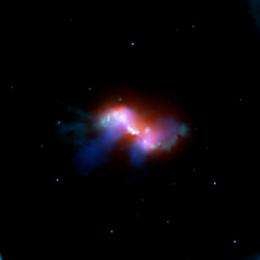An Intriguing, Glowing Galaxy

A supermassive black hole may be responsible for the glowing appearance of galaxy 3C 305, located about 600 million light years away in the constellation Draco. Composite data from NASA’s Chandra X-ray Observatory and other telescopes suggests that the black hole may be interacting with interstellar gas and emitting X-rays. Or, bright radiation from regions near the black hole may infuse energy into the gas that makes it glow.
Activity from a supermassive black hole is responsible for the intriguing appearance of this galaxy, 3C 305, located about 600 million light years away from Earth. The structures in red and light blue are X-ray and optical images from the Chandra X-ray Observatory and Hubble Space Telescope respectively. The optical data is from oxygen emission only, and therefore the full extent of the galaxy is not seen. Radio data are shown in darker blue and are from the NRAO's Very Large Array in New Mexico, as well as the Multi-Element Radio-Linked Interferometer Network in the United Kingdom.
An unexpected feature of this multiwavelength image of 3C 305 is that the radio emission -- produced by a jet from the central black hole -- does not closely overlap with the X-ray data. The X-ray emission does, however, seem to be associated with the optical emission.
Using this information, astronomers believe that the X-ray emission could be caused by either one of two different effects. One option is jets from the supermassive black hole (not visible in this image) are interacting with interstellar gas in the galaxy and heating it enough for it to emit X-rays. In this scenario, gas heated by shocks would lie ahead of the jets. The other possibility is that bright radiation from regions close to the black hole infuses enough energy into the interstellar gas to cause it to glow.
Deeper X-ray data will be needed to decide between these alternatives.
Provided by NASA



















